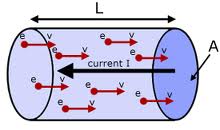Definition and Concept of Drift Velocity
– Drift velocity is the average velocity attained by charged particles in a material due to an electric field.
– It is the result of the net flow of charged particles in one direction, superimposed on their random motion.
– Drift velocity is proportional to current and the magnitude of an external electric field.
– It can be explained by Ohm’s law, where drift velocity (u) is equal to the product of electron mobility (μ) and electric field (E).
– In the MKS system, drift velocity is measured in m/s, electron mobility in m/(V·s), and electric field in V/m.
Experimental Measurement of Drift Velocity
– The formula for evaluating drift velocity is u = j / (nq), where j is the current density, n is the charge-carrier number density, and q is the charge on the charge-carrier.
– Drift velocity and current density are vectors, so their relationship is often written as J = ρu, where ρ is the charge density.
– In terms of a right-cylindrical current-carrying metallic conductor, the expression for drift velocity can be rewritten as u = (mσΔV) / (ρefℓ), where m is the molecular mass of the metal, σ is the electric conductivity, ΔV is the voltage applied, ρ is the density of the conductor, e is the elementary charge, and ℓ is the length of the conductor.
Numerical Example of Drift Velocity Calculation
– Copper, commonly used for conducting electricity, has a density of 8.94g/cm³ and an atomic weight of 63.546g/mol.
– In 1m³ of copper, there are approximately 8.5×10^28 electrons.
– Assuming a current of 1 ampere and a wire with a diameter of 2mm, the cross-sectional area is 3.14×10^-6 m².
– The charge of one electron is -1.6×10^-19 C.
– Using the formula u = I / (nAq), the drift velocity is calculated to be 2.3×10^-5 m/s.
Comparison with Thermal Speed and Electron Flow
– The drift speed of electrons is generally in the order of 10 m/s, while the thermal speed is on the order of 10^5 m/s.
– Due to the small drift velocity, there is a net flow of electrons opposite to the direction of the electric field.
– At 60Hz alternating current, the average drift distance within half a cycle is less than 0.2 m.
– Out of around 1×10^10 movable electrons per meter of wire, the number of electrons flowing across the contact point twice per cycle is insignificant.
– By comparison, the Fermi flow velocity of electrons is around 1570 km/s.
Related Concepts and References
– Other related concepts include flow velocity, electron mobility, speed of electricity, drift chamber, and guiding center.
– A reference for further reading is ‘Introduction to Electrodynamics’ by David Griffiths.
– Ohm’s Law: Microscopic View at Hyperphysics provides additional information on the topic.
– The content is retrieved from the Wikipedia page on Drift Velocity. Source: https://en.wikipedia.org/wiki/Drift_velocity
In physics, drift velocity is the average velocity attained by charged particles, such as electrons, in a material due to an electric field. In general, an electron in a conductor will propagate randomly at the Fermi velocity, resulting in an average velocity of zero. Applying an electric field adds to this random motion a small net flow in one direction; this is the drift.

Drift velocity is proportional to current. In a resistive material, it is also proportional to the magnitude of an external electric field. Thus Ohm's law can be explained in terms of drift velocity. The law's most elementary expression is:
where u is drift velocity, μ is the material's electron mobility, and E is the electric field. In the MKS system, drift velocity has units of m/s, electron mobility, m2/(V·s), and electric field, V/m.
When a potential difference is applied across a conductor, free electrons gain velocity in the direction, opposite to the electric field between successive collisions (and lose velocity when traveling in the direction of the field), thus acquiring a velocity component in that direction in addition to its random thermal velocity. As a result, there is a definite small drift velocity of electrons, which is superimposed on the random motion of free electrons. Due to this drift velocity, there is a net flow of electrons opposite to the direction of the field. The drift speed of electrons is generally in the order of 10-3 meters per second whereas the thermal speed is on the order of 106 meters per second.

